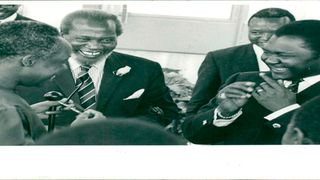
President Jomo Kenyatta, Tanzania President Julius Nyerere and Tom Mboya engage in a light banter at the Nairobi Airport on March 30, 1968. Tom Mboya was assassinated on July 5, 1969.
| File | Nation Media GroupWeekend
Premium
Tom Mboya: The man Kenya cannot forget
What you need to know:
- Former Cabinet Minister Tom Mboya was shot dead in Nairobi on July 5, 1969 aged just 39.
- History, it has been said, admires the wise but elevates the brave. And history is kind to Tom Mboya.
Tom Mboya’s life is like a loud and dramatic narrative — with allegorical flashes of lightning and claps of thunder — he was spectacular and flamboyant. Like the biblical Prophet Elijah, he enters Kenya’s political scene like a tempest and goes out in an instant like a whirlwind; only that Elijah goes out in a chariot of fire and Mboya is gunned down.
Mboya lived in a charmed time; a place so enchanted with its post-independence idealism that it belongs in a fairy tale — which was shattered by a bullet when Mboya was assassinated in Nairobi on July 5, 1969.
However, even though he died at only 39 and his name is now concomitant with tragedy, greatness didn’t elude him. His intelligence and oratory skills won him a place in the world. He was the first Kenyan to be featured on the front-page cover of Time magazine on March 7, 1960.
History, it has been said, admires the wise but elevates the brave. And history is kind to Tom Mboya; his charming image is frozen in mostly black and white photographs and a few Youtube videos — and he is forever young.
He always lurks in our collective memory — never too close and never too far but lingers on in a way that haunts our national conscience. We don’t want to remember him too much — that makes us guilty. And can’t forget him too much — that makes us guilty too.
The book, Tom Mboya: The Man Kenya Wanted to Forget by David Goldsworthy, immortalizes him. Goldsworthy writes with fierce passion — he holds the mirror before our eyes as the society that murdered Tom Mboya in broad daylight. And he doesn’t let us forget that. Even as we read of the eloquent and brilliant Mboya in the book, we hear the menacing growls of politics like a ravenous beast in the background.
In reviewing Goldsworthy’s book, John Lonsdale summarises Mboya’s solid achievements: “The framework of the events which Mboya moulded and by which he accumulated power is familiar: the Mombasa Dock Strike of 1955; the student airlift; the boycott of successive colonial constitutions…; the defeat of Odinga…” There is no doubt that Mboya was a fierce nationalist, a developmentalist and, as described elsewhere, “an ambitious and ruthless power dealer”. Being a unionist, he was most likely a hard charging and hard-driving bargainer.
Tom Mboya's legacy
Zaki Ergas also agrees that Tom Mboya achieved no mean feat: “In the relatively short span of 15 years, from 1950 to 1965, while still in his early youth, Mboya had successfully built a tentacular and impressive power base which included: the trade union movement, the branch machines of the Kenya African National Union, the ‘K.A.N.U. – B’ parliamentary faction, and his ‘American connection’”.
With this American connection, Mboya worked with John F. Kennedy (later-to-be American President) and Martin Luther King Jr “to create educational opportunities for African students, an effort that resulted in the Kennedy Airlifts of the 1960s enabling East African students to study at American colleges”. This one initiative, even without looking at the others, gave his efforts lasting impact on the education of Kenyans.
Apart from all this, one wonders what kind of Kenya he must have envisioned and which he tried to build. Mboya was in all probability an idealist but he tried to be practical in order to put those ideas into action. He issued the Sessional Paper No. 10 in April 1965 under the title “African Socialism and its Application to Planning in Kenya”.
It is said that he neither advocated for wholesome capitalism nor pure socialism but a blended approach with certain aspects of both. This is what he called “African socialism” and has been defined as “a belief in sharing economic resources in a traditional African way, as distinct from classical socialism”.
His legacy can be inflated or disputed but no one can really begrudge his prominent place in history. He left an indelible mark. With others, Mboya has now ballooned into myth – a larger-than-life figure even in fiction. In her novel, Dust, Yvonne Owuor writes that “dying had started long ago. Long before the murder of… Pio, Tom, Argwings, Ronald, Kungu, Josiah, Ouko, Mbae. The others, the ‘disappeared unknown’. National doors slammed over vaults of secrets; threats loomed. The wise chose cowardice, a way of life: not hearing, not seeing, never asking, because sound, like dreams, could cause death” in a country whose official languages are ‘English, Kiswahili, and Silence’”.
Tom Mboya will always remain as that leader who provokes us to always think of what could have been: would things have been better or worse had we taken a different path as a country?





